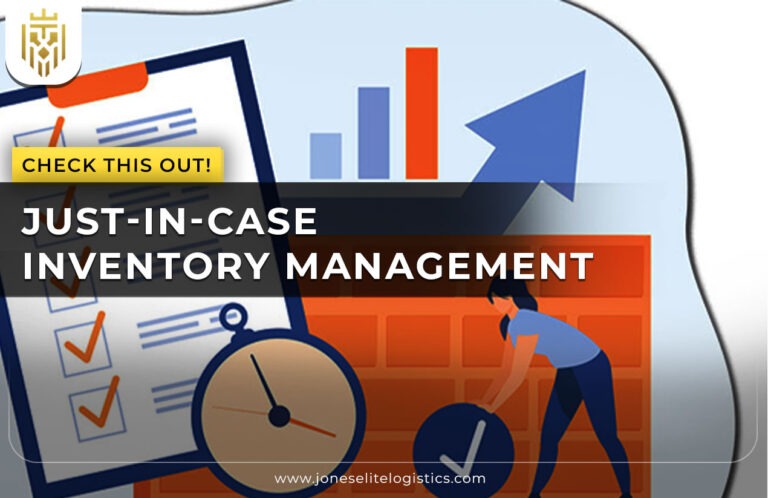Understanding Just-in-Case Inventory in Supply Chain
Just-in-Case (JIC) inventory management concentrates on keeping extra stock to accommodate unexpected demand or supply disruptions. It makes sure that companies are still ready and active even when the market is unpredictable.
This method is based on the idea of preparedness. Instead of depending only on accurate forecasts, companies that practise JIC get ready for probable disruptions in the supply chain, changes in geopolitics, and variations in the market. They prevent themselves from losing production time, going overdue in deliveries, and missing sales opportunities by keeping more goods. This method is particularly important in industries where high customer expectations prevail and any delay may ruin the brand’s reputation.
Key Features of Just-in-Case Inventory

The JIC approach includes essential features that help balance stock and maintain supply chain stability. Each element ensures smooth operations and readiness for sudden changes.
Buffer stock to avoid stockouts
Buffer stock is at the core of the JIC model, and it is crucial for avoiding stockouts. This safety net supports companies that are dealing with unpredictable markets and are dependent on complicated global supply chains. When the suppliers don’t deliver on time or the demand goes up unexpectedly, the buffer stock makes sure that the customers receive their orders anyhow. It plays an important role in avoiding revenue loss, production stoppages, and losing customer goodwill.
Warehouse management that prioritises storage capacity
The JIC strategy cannot be implemented without proper warehouse management. The companies have to think about building their warehouses in a way that it will be easy to process and store the extra stock without really making it hard to get the other stock. Companies should not only invest in storage systems such as racking, automation, and digital inventory tracking, but also exhaust this investment to maintain order and reduce retrieval time. The well-planned warehouses are also cost-saving measures against misplaced items or damaged stock.
Stock Optimisation
JIC is not one of the methods that encourage holding extra stocks without limits; on the contrary, it requires thoughtful optimisation. The stock levels should regularly be adjusted so that the costs of storage are not higher than the benefits of availability. Sophisticated software tools can assist in predicting the curves and recognising the slow-moving items; thus, the managers can change the procurement timelines. The proper stocking of the inventory means that there is no under-stocking, and no overstocking which is the lean and resilient inventory.
Safety stock to handle sudden demand
Safety stock is a precautionary measure against the uncertainties in the supply chain. At the same time, it is an assurance to the companies that they will be able to cater to the demand even if the suppliers are unable to deliver or if the logistics face delays. For example, seasonal businesses or industries that are likely to experience transport bottlenecks are the ones that will benefit the most from the maintenance of safety stock. By planning around realistic lead times and risk factors, organisations can reduce the stress caused by unplanned shortages.
Why is the JIC Method used in the supply chain
The JIC method plays a vital role in helping businesses handle uncertainty. It focuses on maintaining sufficient stock to reduce risks and ensure continuous operations.
Risk Mitigation
The JIC method provides benefits, especially for companies that are exposed to the risk of production disruptions, which are caused by the delay of suppliers or transportation issues, or global uncertainty. The storage of extra stock gives the firm a degree of protection against these external threats. It makes sure that the production line keeps going even if the main suppliers go through hard times. Consequently, companies are able to service customers uninterrupted and to avoid the tying up of money in the production downtime.
Continuity of Operations
One of the strongest arguments in favour of JIC is the operational continuity. If the supply chain is disrupted by unforeseen events, then the presence of stock will prevent costly halts. It allows the companies to fulfil orders while their competitors will still be looking for solutions. In the modern fast-paced market, uninterrupted operations are very important for both gaining and keeping customers’ trust and business reputation.
Customer Satisfaction
Reliability is a customer demand, and JIC plays a key role in that. Customer confidence is built up gradually when the products are always present, and it culminates in the development of brand loyalty. Quick delivery is a factor that positively affects customer relations and leads to repeat purchasing. During the times of shortages, JIC gives the companies the upper hand over their competitors in the promise-keeping category, which is a very important area in industries with intense competition.
Flexibility
A flexible supply chain is an asset to the business when it comes to sudden opportunities or crises because it allows the company to respond at once. The JIC model does just that by keeping a stock cushion which is able to absorb the changing demand curves. It puts the managers in the position to either take on large orders or cope with seasonal peaks without straining the resources. This quality is what makes the companies that have JIC flourish while still keeping their stability.
Advantages of Just-in-Case Inventory

The JIC approach offers several key advantages that strengthen a company’s supply chain. It helps businesses stay resilient, meet customer needs, and maintain consistency.
Stringer Supply Chain Resilience
The JIC inventory method showcases its resilience since it allows businesses to continue functioning even during periods of external volatility. Trust among suppliers, distributors, and customers is built during this whole process of supply chain resilience, and thus, the flow of products is ensured even in tough times.
Enhanced Customer Satisfaction
The presence of products on a consistent basis encourages customers to stay and to trust the brand. The clients get their orders on time, and thus, their trust in the company’s reliability grows. Gradually, this reliability turns out to be a competitive edge that boosts brand reputation and customer relations.
Protection Against Uncertainty
The just-in-case inventory system serves as a protective barrier to prevent the impact of the market’s unpredictability, shortage of resources, and delay of transport. Companies make themselves stable by being prepared for events that would otherwise blockade their operations. This preparedness leads to less anxiety in supply chain management and thus, better decision-making.
Continuity in Global Supply Chains
In the case of multinational companies, JIC is a promise that the complexities of cross-border would be easily managed. It equips firms with the tools required to deal with problems like customs delays, shipping backlogs, and changes in geopolitical situations. Having stock spread over different regions not only keeps products available but also ensures that there is uninterrupted service globally.
Disadvantages of Just-in-Case Inventory

While JIC offers strong protection against uncertainty, it also comes with a few drawbacks. Businesses must balance preparedness with cost efficiency to avoid challenges.
Risk of Obsolescence
The inventory in excess will sometimes lead to products that are no longer in use or even expired, especially in industries where the product is constantly changing. The company has to deal with the constant task of managing shelf life and product relevance. If efficiency fails in stock rotation, the result may be write-offs or waste, which will negatively affect profit margins.
Complex Stock Control
The very nature of the large inventories necessitates very exact control and constant monitoring. Without very strong systems, stock management can become inefficient and prone to mistakes. The businesses will need to have not only advanced tools but also very well-trained staff to ensure that data is tracked accurately and that inventory movement is smooth.
Tied-up Capital
JIC needs large amounts of money in stock which are then tied up funds that could otherwise be used to finance business expansion or new products. This situation limits liquidity and flexibility in financial planning. To counter this, companies have to perform a thorough analysis of their cost structures and make sure that the returns are worth the investment.
High Storage Costs
The storage space must be larger, or new ones have to be built when stock increases. The company’s rental, labour, and utility expenses will therefore increase. Over time, high storage costs can eat up profitability unless the company is able to manage the costs through automation or cost-saving infrastructure improvements.
Just-in-Case vs Just-in-Time
Just-in-Case (JIC) and Just-in-Time (JIT) are two opposite methods for managing stock. JIC, on the other hand, places a high value on having extra stock, whereas JIT, on the contrary, is all about being efficient with very little stock. JIC guarantees to be ready for any unexpected situation in the supply chain, whereas JIT is all about reducing waste and enhancing the flow of money. A lot of contemporary companies are following a blend strategy in which they keep core JIT practices but at the same time hold selective JIC reserves for products that are critical to their business. This equilibrium provides companies with the needed flexibility without sacrificing control over costs.
When to Use Just-in-Case Inventory
JIC inventory is ideal for businesses facing uncertain demand or unstable supply conditions. It helps ensure smooth operations and customer satisfaction in unpredictable markets.
During Disruptions or Instability
JIC proves to be a very important strategy in scenarios where the markets are not stable or the supply chain is disrupted frequently. It gives companies the possibility of avoiding downtimes and keeping their service levels. This strategy was once again practised in global crises like the pandemic, where continuance of supply was a matter of survival for businesses.
Customer Expectations for Immediate Availability
In the case of customers being very demanding with the product availability, JIC is totally in favour of the business that is going to make the delivery at once. Being this fast and ready is a positive sign for the company that it is reliable and customer-orientated. The company is gaining customer loyalty and improving the brand reputation by meeting the high customers’ high expectations.
Demand is Unpredictable
JIC is the one that poses the most significant advantages for industries with unpredictable demand. It gives them the power to deal with a sudden rise in orders without frightening the operations. This insight ensures that opportunities are not lost due to the stock not being available.
Best Practices for JIC Inventory

To make JIC inventory effective, businesses should adopt a structured and data-driven approach. Proper planning ensures resilience without excessive costs.
Efficient Warehouse Management
Effective control of large inventories is possible by optimising the warehouse layout and automation. Smart storage systems and barcode tracking can increase accuracy and speed of retrieval. After all, the continuous training of warehouse staff is a key factor in stock handling efficiency and error reduction.
Supplier Diversification
The risk of supply chain breakdowns is reduced by relying on several suppliers. The partnership with both regional and global vendors will provide various options during the tough times of disruption. A long-term, transparent relationship with suppliers will foster trust, and delivery reliability will be built.
Balanced Inventory Planning
The balance between stock adequacy and overstocking is crucial. With the help of predictive analytics, companies will be able to forecast demand more accurately and cut down on excess. This sort of planning is a way to avoid financial strain while having the stock ready.
Data-Driven Forecasting
Data analytics tools are much needed in refining JIC strategies. These tools are capable of providing data on buying patterns, supplier performance, and seasonal fluctuations. With the help of real-time data, companies will be able to make timely decisions and effectively improve their operations.
Cost-Benefit Analysis
The JIC model’s continued profitability can be assessed through the regular evaluation of storage and handling costs. Comparing the financial aftermath of preparedness versus possible losses from breakdowns ensures strategic alignment. This evaluation makes operations both sustainable and competitive.
FAQs
1. How does JIC affect supplier relationships?
JIC can foster supplier relationships by assuring interdependent ordering and facilitating long-term partnerships. Nonetheless, sometimes it necessitates the use of adaptable contracts to cope with the changes in demand and to maintain equity among the partners.
2. What tools support JIC inventory planning?
JIC planning is supported by modern inventory management platforms, ERP systems and predictive analytics software. The usage of these tools increases visibility, enhances procurement and makes the operations of storage more efficient.
3. Is JIC inventory sustainable in the long term?
Yes, JIC can be made sustainable if constant monitoring and evaluation take place. Companies that are always optimising their stock and employing warehouse technologies will be able to keep the right balance between costs and reliability.
4. Does JIC inventory reduce operational risks?
Certainly. JIC allows companies to be ready for the sudden supply chain disruptions and maintain operations throughout. It provides a safety net that keeps both production and distribution going during harsh conditions.









